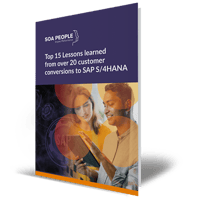Intelligent Enterprise is the new generation of SAP Business Suite that is transforming and simplifying decision making in real time. It’s providing more visibility and control and a single source of truth for data based on both internal and external sources. But as with its architecture and project approach, the SAP S/4HANA On Premise licensing slightly differs to standard ERP licensing.
To help de-mystify the complexity, here’s a guide on what you need to know about SAP S/4HANA licensing.
The 4 types of SAP S/4HANA licenses you are likely to need
- Enterprise Management
This license is the direct user access to the digital core. There are four licensing options depending on type of usage:
- Productivity use: for those who are not heavy users, maybe they are just doing a few tasks on SAP S/4HANA in the warehouse
- Functional use: this is for the normal level of user
- Professional user: for the heavy user who spends more time in SAP S/4HANA
- Developer access: for the people who needs to add content in the system
- By industry solution or line of business
This is the direct user access to additional functionality based on industry or line of business which is licensed separately. Examples include extended functionality for cash management and central procurement. While the Enterprise Management license provides functionality for core areas, there are around 100 industry and line of business specific licenses that you can purchase to extend the core functionality.
- HANA
You will need a license to run the HANA database. There are two options:
- The most common one is the run-time license which allows you to run the HANA database with SAP S/4HANA. For this license you will pay 15% of the total SAP S/4HANA software value of your ERP.
- The second option is the HANA Enterprise Edition (full use) which on top of the runtime right allows you to build applications or data integration scenarios directly in HANA.
- Licensing indirect use for the digital core
This type of license may be required if you have third-party applications or business partners that need to connect to SAP S/4HANA. This is another big topic, we are not going deep here, because this blog is about S/4HANA licensing.
For existing ERP customers: how to provide direct user access to the digital core and industry solutions on SAP S/4HANA On Premise
As an existing on-premise ERP licensed customer with named users, you can re-use your existing ERP user licenses. You will simply need to pay 9,000 Euros for the SAP S/4HANA Enterprise Management for ERP customers (flat fee) license. You will also need the HANA license if you haven’t already got one. On top of this, depending on your specific needs you may wish to optionally purchase one of the industry or LoB focused extensions.
No surcharge on like for like functionality
SAP follows the principle of one, so one solution for one business problem. If only the core functionality is used in SAP S/4HANA the same way as in ERP, then you will not be required to pay for additional licenses. For example, if you use Extended Warehouse Management embedded in S/4HANA the same way/extent as WM in the Business Suite now, even if you are using Extended WM, you don’t have to pay for additional licenses.
As a customer you will want to be very clear about what is included in the core access and what is payable as an extra add-on.
The paths to SAP S/4HANA family and transition
As an ERP customer, you can choose either a product conversion or a contract conversion:
Product conversion
With product conversion you keep the same contractual agreements and you are entitled to a 100% credit for a new license on an equivalent product. You cannot simply swap over to a new license, and the new license may be more expensive. This is because the new product is newer and will have more functionality than the previous one. This approach does have advantages as it allows you to do a step-by-step conversion rather than re-licensing your entire landscape in one go.
Contract conversion
You may wish to change your complete contract to SAP S/4HANA-based contract. If you do this then you have the freedom to get completely new licenses. This is often called a ‘milkshake’ approach as it allows you to give back everything you don’t need and start afresh. However, to do a contract conversion the value of your new licenses needs to be minimum 10% higher than your original ones.
Simplifying the complex for you
This high-level view aims to give you an insight into how licensing works with SAP S/4HANA. There is a lot of complexity around licensing, and if you’d like to explore further the implications and potential costs of your migration please feel free to contact us.



